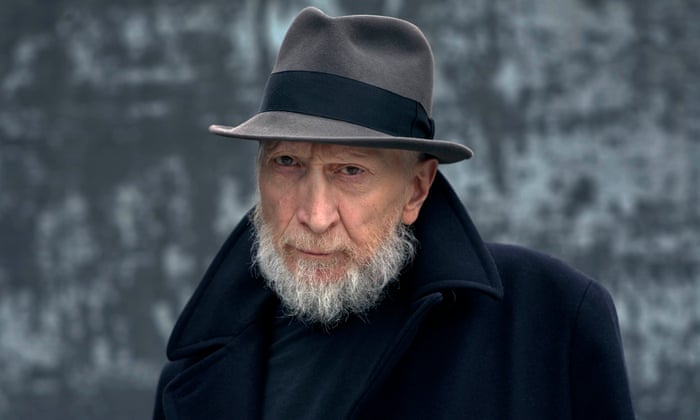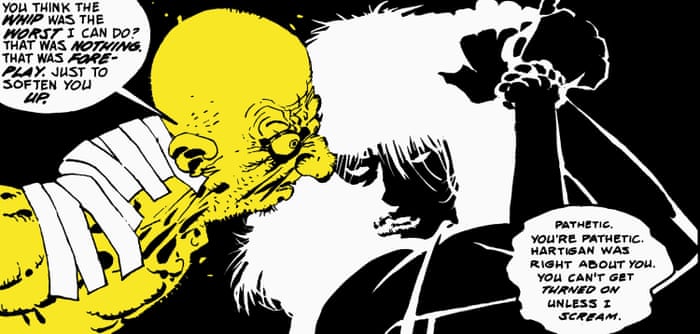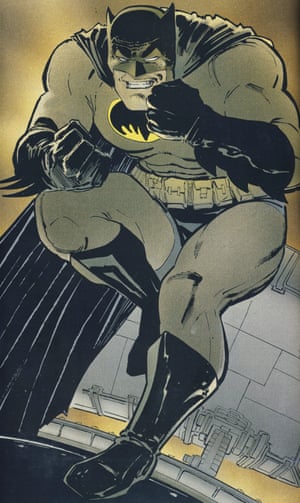 |
| Frank Miller Photograph: Tim Knox |
Interview
Frank Miller: 'I wasn't thinking clearly when I said those things'
After stirring up outrage lambasting Muslims and Wall Street protesters, The Dark Knight Returns creator has been awol from the comics world. He discusses the mentor who got him back on his feet, what he thinks of Donald Trump, and his new prequel to 300
Sam Thielman
Friday 27 April 2018
As far back as he can remember, Frank Miller always wanted to draw a gangster. “I decided that I wanted to make comic books when I was five years old,” the cartoonist says. “I declared to my parents that I was going to do that for the rest of my life.” He’s wearing a black T-shirt with a drawing of Benedict Cumberbatch as Sherlock Holmes and the words “high-functioning sociopath”, a white beard that makes him look older than his 61 years, and a near-constant smile.
In photos, Miller scowls heavily into the camera, the very image of the kind of grizzled tough he might have drawn in Sin City. But in conversation he is very clearly not a sociopath: in fact, he is a little anxious and very friendly and eager to talk about all his titanically influential works: Sin City, Batman, Daredevil. After a long absence from the public eye, he is suddenly everywhere again. In March he signed a five-project deal with DC Comics that includes penning a new Superman graphic novel. He bagged another deal, with Netflix and Simon & Schuster, for an Arthurian-themed project called Cursed.
And his latest graphic novel is already underway: Xerxes, a prequel to 300, his tale of the ancient battle of Thermopylae, adapted for film by Zack Snyder in 2006. The new series is set to span the rise and fall of the Persian empire: from before the birth of the ambitious and bloodthirsty titular king, to the life of his son and the rise of Alexander. Miller is fascinated by the period. “The Spartans were strange catalysts of democracy,” he says. “They were utter fascists. They had the best land in Greece, and it was tilled by slaves and the citizens were all soldiers to defend the territory. The Athenians were the ones who gave birth to democracy, but the Spartans made it all possible.”
These are the first substantial projects Miller has had in several years, barring a halting return to comics in 2015, when he worked on a Batman graphic novel. His writing is sometimes criticised as unsubtle – his villains tend to be terribly bad and his heroes tremendously good – but his visual style is unmistakable, even as it has changed radically over his 40-year career. During a long run on Marvel’s Daredevil, his subjects’ anatomy evolved from conventional superhero fodder. His almost caricature figures in The Dark Knight Returns, posed against intricate backgrounds, made his take on Batman an instant classic. When he drew Sin City, he changed again: drowning his pages in black ink and rendering cityscapes with only flecks of light—its last arc is almost hallucinatory, a black-and-white series that explodes into full colour after the hero is pumped full of a toxin by his enemies.
Miller’s politics seemed to become more eccentric as his drawing did the same. In 2011, he published what he called “a propaganda comic”: Holy Terror, a gory tale of a caped superhero taking on al-Qaida. In one scene, the hero tortures a suicide bomber as his Catwomanish girlfriend observes that she’s “OK with that.” It’s just one of the book’s many other acts of gory revenge on Miller’s Muslims, who stone and behead people and scream, “Praise Allah!” Readers and critics responded with bafflement and anger; one critic called it “one of the most appalling, offensive and vindictive comics of all time”.
That same year, Miller went on a tirade against the Occupy Wall Street movement, describing it in a blog as “a pack of louts, thieves, and rapists … Wake up, pond scum. America is at war against a ruthless enemy. Maybe, between bouts of self-pity and all the other tasty tidbits of narcissism you’ve been served up in your sheltered, comfy little worlds, you’ve heard terms like al-Qaida and Islamicism.” Miller was again branded a reactionary.
“My stuff always represents what I’m going through,” Miller says today. “Whenever I look at any of my work I can feel what my mindset was and I remember who I was with at the time. When I look at Holy Terror, which I really don’t do all that often, I can really feel the anger ripple out of the pages. There are places where it is bloodthirsty beyond belief.”
Does he have any regrets? “I don’t want to go back and start erasing books I did,” he replies. “I don’t want to wipe out chapters of my own biography. But I’m not capable of that book again.”
It’s worth noting that whatever his detractors may think of his politics, Miller still happily inveighs against “white, heterosexual family values” and has no interest in defending his views on Occupy Wall Street. “I wasn’t thinking clearly,” he confesses. Does he support Donald Trump? “Real men stay bald,” he says with a grin, lifting his hat to run a hand over his bare scalp.
Miller got his start in comics in the late 1970s, when he was in his early 20s, after his dad helped him move to New York City to chase his dream of making it as a comic-book illustrator. Eager to get started, he made three calls: one each to DC and Marvel, and a third to his hero: Neal Adams, whose Batman and Green Lantern comics had made him a superstar. Adams’s daughter answered the phone; Miller convinced his idol to take a look at his portfolio.
Adams credits his daughter with his decision to give Miller a chance. “Obviously she felt sorry for him because he was a skinny kid who looked like Ichabod Crane,” he says. Miller’s portfolio was “awful,” he says, laughing. “It was so bad. My heart sunk, and I was like, ‘Oh my God, one of these guys.’”
Many artists were so humiliated by the harsh feedback Adams gave that they never came back – not Miller. (“Anything but!” Miller exclaims. “It was exhilarating that my idol was that generous with his time!”)
But Miller’s subsequent success, Adams says, is not his doing. “Whatever you do, don’t say that I’m responsible for Frank Miller,” he warns. “I’ve done the same thing for a hundred guys and nobody responded the way Frank did. Nobody advanced that quickly. And I made it hard for him! If you’d gone through it, you’d have gone home crying. I never would have thought that he’d turn out to be what he is. He’s become like a son to me. I didn’t teach him any other of life’s lessons, unfortunately, and I should have. That was the bad part.”
 |
| A panel from Sin City. |
Why did Miller take a years-long sabbatical from the medium he’d pursued his whole life? Adams blames the traditional trappings of fame – bad influences and alcohol. When asked about his absence, the limit to Miller’s candour is revealed. “I just got very distracted by real life,” he says. “I’d rather not go into it.” Through a publicist, he declined to respond to his mentor’s assessment.
Adams wishes he’d told Miller that life wasn’t just work. “We just talked about work. And if you don’t teach family or good health to somebody, then suddenly you turn around and go, ‘Oh, my God. We didn’t have that conversation.’ And you feel like shit, because Frank didn’t. And now he’s having to learn it.”
In part, he blames Miller’s success for the years he says his friend sacrificed to that lesson. “You cannot accept other people’s view of you. You cannot believe when other people say, ‘Oh my God, you’re great, you’re a legend.’ You cannot accept that. It’s no way to live. And as soon as you do, you start convincing yourself that you’re something that you’re not, that somehow you can drink two bottles of whiskey and nothing will happen to you.”
In his last conversation with Miller, Adams says he told his protege he was going to die. “I told him he was white trash, and I’d be surprised if he makes it for six months, because he’s taken his life and ruined it, and he said, ‘Well, I’d like to show you I’m not that way,’ and I said, ‘If you recover, I’ll see you in six months, maybe a year.’”
“‘I think of you like a son,’” Adams remembers saying, “‘and I’m gonna lose you.’” Now he believes Miller “will mend”.
Forty years in the business – even with the break – and Miller is still here, having his makeup adjusted in between sips of tea in a photography studio in Manhattan, the city that has been his most reliable and consistent source of inspiration. Perhaps the best evidence that Adams is right is also fairly simple. Frank Miller’s drawing again.
- Due to an editing error, this piece conflated Sin City and 300; this has been corrected.



No comments:
Post a Comment